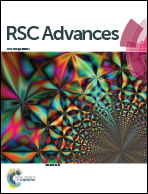Unusual morphologies of reduced graphene oxide and polyaniline nanofibers-reduced graphene oxide composites for high performance supercapacitor applications†
Abstract
Herein, we have demonstrated the nanostructured rose flowers, sheets, rods and ferns of reduced graphene oxide by using oxalic acid as a reducing agent. The various morphologies of reduced graphene oxide were obtained by time dependent reduction of graphene oxide. The composites of reduced graphene oxide based polyaniline nanofibers, flower bouquet, and honeycombs were grown at a moderate temperature (60 °C) by in situ polymerization of aniline. The structural characterization of composites was performed by using X-ray diffraction, and the existence of reduced graphene oxide in different size, shape and thickness was confirmed by Raman spectroscopy and transmission electron microscopy study. The electrochemical study of reduced graphene oxides and their composites with polyaniline nanostructures was performed. The composite of honeycomb reduced graphene oxide–polyaniline nanofibers showed enhancement in the electrochemical performance (specific capacitance: 470 F g−1) compared to earlier reports. Such type of composites will be a potential contender for super capacitors.


 Please wait while we load your content...
Please wait while we load your content...